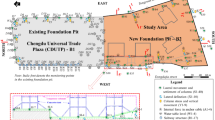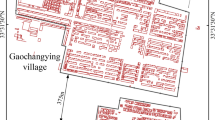Abstract
A model of an inclined coal seam floor with linearly increasing water pressure was developed based on theories of ground pressure and key strata. The stability metrics of the water-resistant key strata in the inclined coal seam was deduced using Mohr–Coulomb yield criterion. Five principle factors were selected: the distance that the workface had advanced, the tilted length of workface, the thickness and pitch of the water- resistant key strata, and the elasticity modulus. A sensitivity analysis was then conducted using an orthogonal design. The thickness of the water-resistant key strata was the most important factor, with a 44.8% ranking, followed by the distance that the workface had advanced at 34.4%. The influence of the elasticity modulus, pitch, and tilted length of the workface, were 9.3, 5.8, and 5.7%, respectively. The maximum water pressure possibly tolerated by the inclined aquiclude were found to rise with the increasing load of the caved overburden, and decrease with the increasing workface initial or periodic weighting distance, workface length, and pitch of the water-resistant key strata. A parabolic relationship exists between the maximum allowable water pressure and thickness of the key aquiclude. Water-resistant key strata located in the lower part of the confining layer offers better protection from floor water inrush. These findings provide an important theoretical basis to determine the potential of water inrush from an inclined coal seam when mining above confined aquifers.
Zusammenfassung
Für den Fall einfallender Kohleflöze und unter der Annahme linear ansteigender Wasserdrücke wird ein theoretisches Model auf Basis von Grunddrücken und stratigraphischer Schlüsseleinheiten entwickelt. Die Stabilitätseigenschaft einer wasserundurchlässigen Schlüsseleinheit innerhalb eines einfallen Kohleflözes wird durch das Mohr-Coulomb-Feld-Kriterium bestimmt. Fünf prinzipielle Faktoren wurden in dieser Studie unter der Annahme eines Orthogonalfeldes in einer Sensitivitätsanalyse untersucht: eine zunehmende Entfernung des Abbaustoßes, die geneigte Länge des Abbaustoßes, die Mächtigkeit und das Einfallens der wasserundurchlässigen Schlüsseleinheit und das Elastizitätsmodul. Die Mächtigkeit der wasserundurchlässigen Schlüsseleinheit war der sensitivste Faktor (44.8%), gefolgt von der zunehmenden Entfernung des Abbaustoßes (34.4%). Der Einfluss des Elastizitätsmoduls (9.3%), des Einfallens (5.8%) und der geneigten Länge des Abbaustoßes (5.7%) war weniger sensitiv. Der maximale Wasserdruck, welcher durch den einfallenden Wassernichtleiter potenziell tolerierbar ist, steigt grundsätzlich mit dem statischen Überlagerungsdruck an, fällt jedoch mit steigenden (gewichteten) Abbaufortschritten, der Länge des Abbaustoßes und dem Einfallen der Aquiclude. Zwischen dem maximal zulässigen Wasserdruck und der Mächtigkeit der Schlüssel-Aquiclude besteht eine parabolische Beziehung. Wasserundurchlässige Partien, welche sich im unteren Teil eines Geringleiters befinden, bieten einen größeren Schutz gegenüber Liegendwasser-Einbrüchen. Die hier erzielten theoretischen Studienergebnisse tragen dazu bei, das Potenzial von Wassereinbrüchen über einfallenden Kohleflözen bei Bergbautätigkeiten im Hangenden gespannter Grundwasserleiter besser zu bestimmen.
Resumen
Basado en las teorías de presión sobre el suelo y estratos clave, se desarrolló un modelo que relaciona el piso inclinado de una veta de carbón en forma lineal con el incremento de la presión del agua. Las medidas de estabilidad del estrato resistente al agua en la veta inclinada de carbón se dedujeron utilizando el criterio de Mohr-Coulomb. Cinco factores fueron seleccionados: la distancia de avance de la cara de trabajo, la longitud de inclinación de la cara de trabajo, el espesor y el paso del estrato resistente al agua y el módulo de elasticidad. El análisis se realizó utilizando un diseño ortogonal. El factor más importante fue el espesor del estrato resistente al agua, con 44.8%, seguido por la distancia que había avanzado la cara de trabajo con 34.4%. Las influencias del módulo de elasticidad, paso y longitud de la inclinación de la cara de trabajo, fueron 9,3, 5,8 y 5,7%, respectivamente. La máxima presión de agua posible tolerada por el acuífugo inclinada aumenta con la carga excavada y decrece con el avance de la cara de trabajo o con la distancia ponderada por el peso, la longitud de la cara de trabajo y el paso de los estratos resistentes al agua. Existe una relación parabólica entre la máxima presión de agua admisible y el espesor del acuífugo clave. Un estrato clave resistente al agua y localizado en la parte baja de la capa confinada ofrece mejor protección a la irrupción de agua desde el piso. Estos resultados proveen una importante base teórica para determinar el potencial de irrupción de agua desde una veta inclinada de carbón cuando la minería alcance la zona superior a los acuíferos confinados











Similar content being viewed by others
References
Abdelghani FB, Aubertin M, Simon R, Therrien R (2015) Numerical simulations of water flow and contaminants transport near mining wastes disposed in a fractured rock mass. Int J Min Sci Tech 25(1):37–45
Chaulya SK (2003) Assessment and management of water resources for a lignite mine. Mine Water Environ 22:45–51
Fan GW, Zhang DS (2015) Mechanisms of aquifer protection in underground coal mining. Mine Water Environ 34:95–104
Feng QY, Li T, Qian B, Zhou L, Gao B, Yuan T (2014) Chemical characteristics and utilization of coal mine drainage in China. Mine Water Environ 33:276–286
Han J, Shi LQ, Yu XG, Wei JC, Li SC (2009) Mechanism of mine water-inrush through a fault from the floor. Min Sci Tech 19(3):276–281
James P, Dave C (2015) Current research on mine water and the environment in New Zealand. Mine Water Environ 34:363
Kong HL, Miao XX, Wang LZ, Zhang Y, Chen ZQ (2007) Analysis of the harmfulness of water-inrush from coal seam floor based on seepage instability theory. J China Univ Min Tech 17(4):453–458
Li BY (1999) “Down Three Zones” in the prediction of water inrush from coalbed floor aquifer-theory, development and application. J Shandong Inst Min Tech 18(4):11–18
Li LP, Zhou ZQ, Li SC, Xue YG, Xu ZH, Shi SS (2015) An attribute synthetic evaluation system for risk assessment of floor water inrush in coal mines. Mine Water Environ 34:288–294
Liang DX, Jiang ZQ, Guan YZ (2015) Field research: measuring water pressure resistance in a fault-induced fracture zone. Mine Water Environ 34:320–328
Meng Z, Li G, Xie X (2012) A geological assessment method of floor water inrush risk and its application. Eng Geol 143–144:51–60
Miao XX, Liu WQ, Chen ZQ (2004) Seepage theory in mining rock. Science, Beijing
Miao XX, Chen RH, Bai HB (2007) Fundamental concepts and mechanical analysis of water-resisting key strata in water preserved mining. J China Coal Soc 32(6):561–564
Miao XX, Pu H, Bai HB (2008) Principle of water-resisting key strata and its application in water-preserved mining. J China Univ Min Tech 37(1):1–4
Qian MG, Shi PW (2003) Ground pressure and strata control. China University of Mining and Technology Press, Xuzhou
Qian MG, Miao XX, Xu JL, Mao XB (2003) Key strata theory in ground control. China University of Mining and Technology Press, Xuzhou
Sun J, Wang LG (2014) Instability mechanics criterion of inclined water-resisting key strata in coal seam floor. J China Coal Soc 39(11):2276–2285
Sun J, Wang LG, Tang FR, Shen YF, Gong SL (2011) Microseismic monitoring on the failure characteristics of an inclined coal seam floor. Rock Solid Mech 32(5): 1589–1595
Timoshenko SP, Woinowsky-Krieger SW (1959) Theory of Plates and Shells. McGraw-Hill Press, New York (American)
Wang JA, Park HD (2003) Coal mining above a confined aquifer. Int J Rock Mech Min Sci 40(4):537–551
Wang Q, Wang XY, Hou QL (2015) Geothermal water at a coal mine: from risk to resource. Mine Water Environ 34:1–8
Wu Q, Zhou W (2008) Prediction of groundwater inrush into coal mines from aquifers underlying the coal seams in China: vulnerability index method and its construction. Environ Geol 55(4):245–254
Wu Q, Wang MY, Wu X (2004) Investigations of ground water bursting into coal mine seam floors from fault zones. Int J Rock Mech Min 41(4):557–571
Wu Q, Zhou WF, Zhang L (2011) China’s environment: challenges and solutions. Environ. Earth Sci 64:1503–1504
Wu Q, Fan S, Zhou W, Liu S (2013) Application of the analytic hierarchy process to assessment of water inrush a case study for the no. 17 coal seam in the Sanhejian coal mine, China. Mine Water Environ 32:229–238
Wu Q, Fan ZL, Zhang ZW, Zhou WF (2014) Evaluation and zoning of groundwater hazards in Pingshuo No.1 underground coal mine, Shanxi Province, China. Hydrogeol J 22:1693–1705
Wu Q, Xu SH, Zhou WF, James W (2015) Hydrogeology and design of groundwater heat pump systems. Environ. Earth Sci 73:3683–3695
Xu ZL (2006) Elasticity mechanics. Higher Education, Beijing
Xu JP, Liu SD, Wang B, Zhang P, Gui H (2012) Electrical monitoring criterion for water flow in faults activated by mining. Mine Water Environ 31:172–178
Yang C, Liu SD, Liu L (2016) Water abundance of mine floor limestone by simulation experiment. Int J Min Sci Tech 26(3):495–500
Yin SX, Zhang J (2005) Impacts of karst paleo-sinkholes on mining and environment in northern China. Environ Geol 48(8):1077–1083
Yu BY, Chen ZQ, Yu LL (2016) Water-resisting ability of cemented broken rocks. Int J Min Sci Tech 26(3):449–454
Zhang JC (2005) Investigations of water inrushes from aquifers under coal seams. Int J Rock Mech Min Sci 42(3):350–360
Zhang XM, Wang XH (1997) The relationship of coal roof pressure and water-inrush from floor. Coal Geol Expl 25(supp.):51–53
Acknowledgements
This study was supported by the National Natural Science Foundation of China (No. 51404013), the Open Projects of State Key Laboratory of Coal Resources and Safe Mining at the China University of Mining and Technology (No. 13KF01), the China Postdoctoral Science Foundation-funded Projects (No. 2013M540478), and the Natural Science Foundation of Anhui Province (Nos. 1508085ME77 and 1508085QE89).
Author information
Authors and Affiliations
Corresponding author
Rights and permissions
About this article
Cite this article
Sun, J., Miao, X. Water-Isolating Capacity of an Inclined Coal Seam Floor Based on the Theory of Water-Resistant Key Strata. Mine Water Environ 36, 310–322 (2017). https://doi.org/10.1007/s10230-017-0428-6
Received:
Accepted:
Published:
Issue Date:
DOI: https://doi.org/10.1007/s10230-017-0428-6





